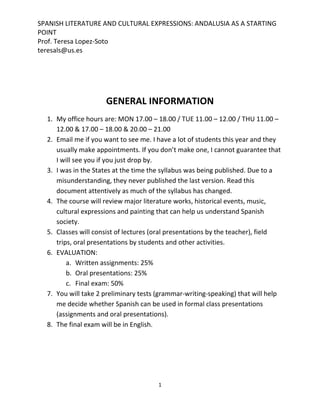Expr cult gen-info
- 1. SPANISH LITERATURE AND CULTURAL EXPRESSIONS: ANDALUSIA AS A STARTING POINT Prof. Teresa Lopez-Soto teresals@us.es GENERAL INFORMATION 1. My office hours are: MON 17.00 ŌĆō 18.00 / TUE 11.00 ŌĆō 12.00 / THU 11.00 ŌĆō 12.00 & 17.00 ŌĆō 18.00 & 20.00 ŌĆō 21.00 2. Email me if you want to see me. I have a lot of students this year and they usually make appointments. If you donŌĆÖt make one, I cannot guarantee that I will see you if you just drop by. 3. I was in the States at the time the syllabus was being published. Due to a misunderstanding, they never published the last version. Read this document attentively as much of the syllabus has changed. 4. The course will review major literature works, historical events, music, cultural expressions and painting that can help us understand Spanish society. 5. Classes will consist of lectures (oral presentations by the teacher), field trips, oral presentations by students and other activities. 6. EVALUATION: a. Written assignments: 25% b. Oral presentations: 25% c. Final exam: 50% 7. You will take 2 preliminary tests (grammar-writing-speaking) that will help me decide whether Spanish can be used in formal class presentations (assignments and oral presentations). 8. The final exam will be in English. 1
- 2. CLASS SCHEDULE (by the week) 28 September: - Presentation course - Spanish test - Assignment no. 1 (writing: ŌĆ£La vida cotidiana en Espa├▒aŌĆØ) 30 September: - Oral Presentation no. 1 (ŌĆ£La vida cotidiana en Espa├▒aŌĆØ) 5 October: - El origen andalus├Ł: las jarchas - Assignment no. 2 (writing: ŌĆ£Influencia ├Īrabe en Espa├▒aŌĆØ) 7 October: - Oral Presentation no. 2 (picture exhibition: ŌĆ£Influencia ├Īrabe en SevillaŌĆØ) 14 October: - Sevilla, Puerto de Indias: la colonizaci├│n de Am├®rica. 19 October: - Field trip no. 1 (ŌĆ£Crist├│bal Col├│nŌĆØ) 2
- 3. 21 October: - Cervantes: Rinconete y Cortadillo 26 October: - Field trip no. 2 (ŌĆ£Miguel de CervantesŌĆØ) 28 October: - Gustavo Adolfo B├®cquer: Las leyendas - Assignment no. 3 (writing: Las leyendas) 2 November: - Field trip no. 3 (ŌĆ£Gustavo Adolfo B├®cquerŌĆØ) 4 November: - La figura del Don Juan 9 November: - Oral Presentation no. 3 (A play: ŌĆ£Don JuanŌĆØ) (Casting) 11 November: - Oral Presentation no. 3 (A play: ŌĆ£Don JuanŌĆØ) (Performance) 16 November: - La figura de la mujer: ŌĆ£CarmenŌĆØ de Bizet 3
- 4. 18 November: - Field trip no. 4 (ŌĆ£CarmenŌĆØ de Bizet) - Assignment no. 4 (writing: La figura de la mujer en Espa├▒a) 23 November: - Oral Presentation no. 4 (La figura de la mujer en Espa├▒a) 25 November: - La religiosidad barroca 30 November: - Field trip no. 5 (Museo de Bellas Artes) 2 December: - Oral Presentation no. 5 (Una visita al museo) 9 December: - La Navidad: los villancicos 14 December: - Final exam: contents 16 December: - Final exam: speaking 4



